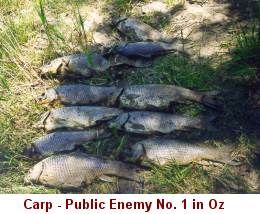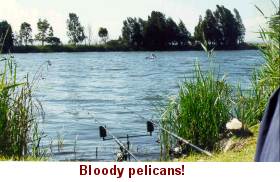Last September while sitting at work scanning through one of my companies advertising booklets I noticed that we had an office in Melbourne, Australia. Never having been there and feeling in a somewhat lucky mood I marched into my bosses office and there and then blurted out a transparently thin argument for needing to go there on an expenses paid business trip.
I suppose if you put it into a fishing context it was a bit like finding a surface cruising carp and rather than carefully feeding it floaters to gain its confidence and then deftly drifting your hookbait into position on the wind, you think ‘what the hell’ and chuck a cast right on top of its head. Well, what do you know, this was the one occasion when rather than bow-waving to the opposite end of the lake, never to be seen again, my boss took the bait quicker than a starving mid-double mirror carp in the middle of a Chum Mixer feeding frenzy and I was on my way!
Now most people faced with a trip down under for the first time I am sure would have their heads filled with visions of Kangaroos, Koala, Aires rock and Barrier reefs. Me, I could only think of one thing – carp! Everyone I told thought I was mad going all that way just to catch a fish. I gave up trying to explain as I am sure the only people who could possibly understand are the ones reading this article! 
Due to work I would only have 10 days there and with less than two weeks before I left the first priority was to find as much information on the fishing over there as possible. This was not easy but the internet was a great help and I managed to build up at least a basic idea of possible places to fish. One area in particular, called Lakes Entrance, seemed to be a good bet. Located on the coast between Melbourne and Sydney it was certainly within striking distance for me in the limited time I had available.
Tackle was kept to a minimum with just one rod tube packed with 3 rods and a landing net. Everything else had to fit in my suitcase or it did not take it. However even when traveling light I always pack plenty of spare line and hooks in particular. When you really get down to it these are the essential items which you will have trouble replacing with the same quality in a foreign country.
For bait I planned to concentrate on particles which are readily available over there. I also took a few packs of boilies as a change. A quick tip here, don’t pack them anywhere near clothes even when wrapped in several plastic bags. I spent two days sitting in meetings smelling like Tutti Frutti. I was surrounded by Australians and desperately trying to convince them it was a fashionable new European aftershave. Thank God I didn’t pack any Monster Crab!
On arrival I spent the first couple of days sorting out a car, permits and baits in Melbourne. Permits are essential nowadays and only cost 10 Australian dollars for 28 days, which is about £ 4. Or 20 dollars for a whole year. So there really is no excuse for not getting one and running the risk of having your tackle confiscated. 
While looking through the tackle shops in Melbourne I got chatting to a few of the other anglers and it became blatantly obvious that Australians have one thing in common when it comes to carp – they hate them. They really are public enemy number one and you will be inundated with tales of how they drive out native species, destroy banks, steal lollipops from babies and are responsible for the hole in the ozone layer – which is directly over Australia!
To even begin to try and explain that you plan to pose with one for a picture before carefully slipping it back will have them staring at you in the same way as if you had said ‘Hello I’m a Martian’ to the checkout girl in Tesco.
There is a serious side to this. It was common to find lines of carp tossed up the bank and left to rot and I quickly found that it was not a good idea to start catching carp in front of other anglers if I wanted to return them alive without any hassle.
As for the fishing itself, although there where numerous lakes and reservoirs that held carp, my attention was directed more towards the rivers and two in particular, the Mitchell and the Tambo. Both hold carp in enormous numbers and both have some very varied fishing on offer. In their lower reaches they are big rivers, wide and deep. I fished here with simple bolt-rigs and it soon became apparent that the fish here traveled in massive shoals and included some very big fish. Find them and the river was literally alive with fish, miss them and you might as well be casting onto a dry bank.
The network of rivers and lakes in this area were linked to the sea and salt levels were a major influence on location here. With the fluctuations in the flow of freshwater from upriver and the changes in the tides downstream the fish were constantly moving to find water with a salt level they could tolerate. It was also common to have a whole host of exotic wildlife swimming, flying or hopping past in the course of a day which obviously added a certain appeal all of its own to the proceedings.
Although I enjoyed fishing the lower rivers and spent a number of days chasing the shoals the most fun I had was on the upper rivers. Here the rivers where smaller and more intimate and stalking really came into its own. One of the most consistent features I found here were the presence of sheer underwater ‘cliffs’ where the river bed rose up from a depth of six or seven feet to a matter of inches in the space of less than a foot. The carp congregated along the edges of these cliffs picking off anything that the river drifted down. I had a great time catching them by wading out to the edge of the drop-off and trotting a float out into the deeper water. If I stayed really still I could get the carp hoovering up bait inches from my feet and I almost had as much fun watching them as catching them.
Sweetcorn outfished boilies by a long way, I even watched carp pushing the boiled baits aside to get a few grains of corn that lay amongst them.
The fish were mainly sleek commons with the very occasional mirror which I saw but was never able to tempt. Although they where not huge – the biggest would have been about 12 pounds – they all left your arm aching on the light tackle. 
My most vivid memory of the whole trip, however, was back on the lower river. Being this close to the sea it was common to be fishing amongst wild pelicans. Oh sure I was in awe the first time a wild one majestically circled my rod tips but awe gradually turned to mild annoyance as it snagged my lines for the third time and mild annoyance turned to full blown anger when it decided to take off through my rods. This became a common occurrence and I started to dread seeing them.
You can therefore imagine how I felt one afternoon when a pelican decided that my landing net was edible and started to drag it into the river. Leaping forward I just managed to grab the handle before it slipped over the edge and then got involved in an almighty tug of war as the wretched bird decided it was not going to give it up without a fight, half pulling me into the river as it attempted to take off. It let go at the last second leaving me in a crumpled soggy heap screaming obscenities at it as it flew away.
It was at that moment that my attention wandered over to the opposite bank. As I had been sitting low behind some reeds I had not noticed that several families had setup to have a barbecue right at the water’s edge. Every head was now turned and staring straight at me. I slowly lowered myself back behind the reeds and sobbed.
And you thought you had it bad with Tufties!












